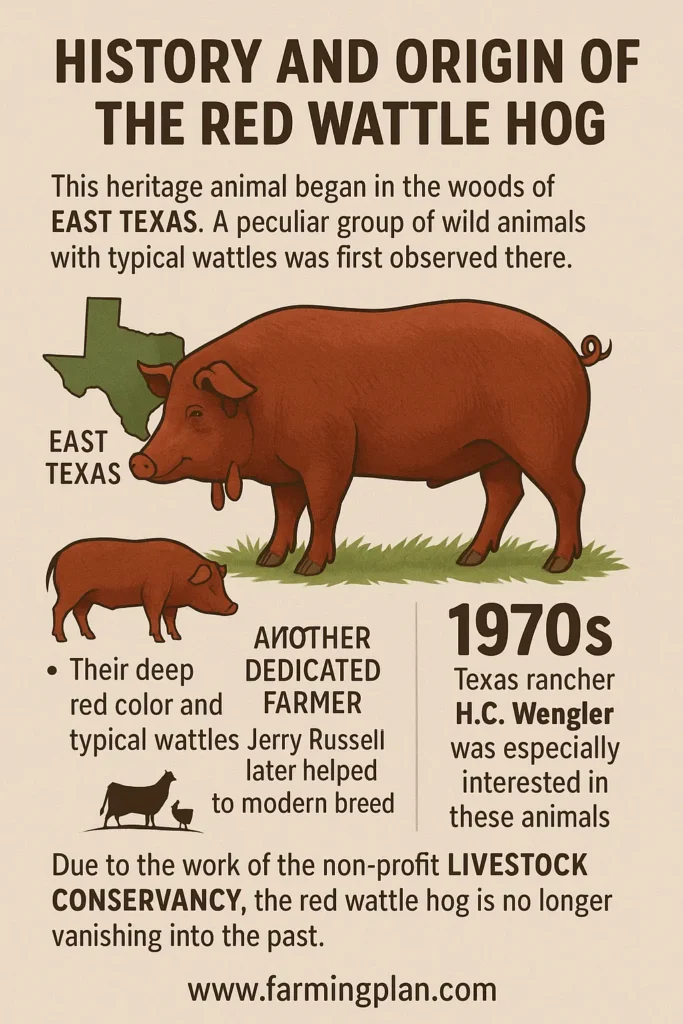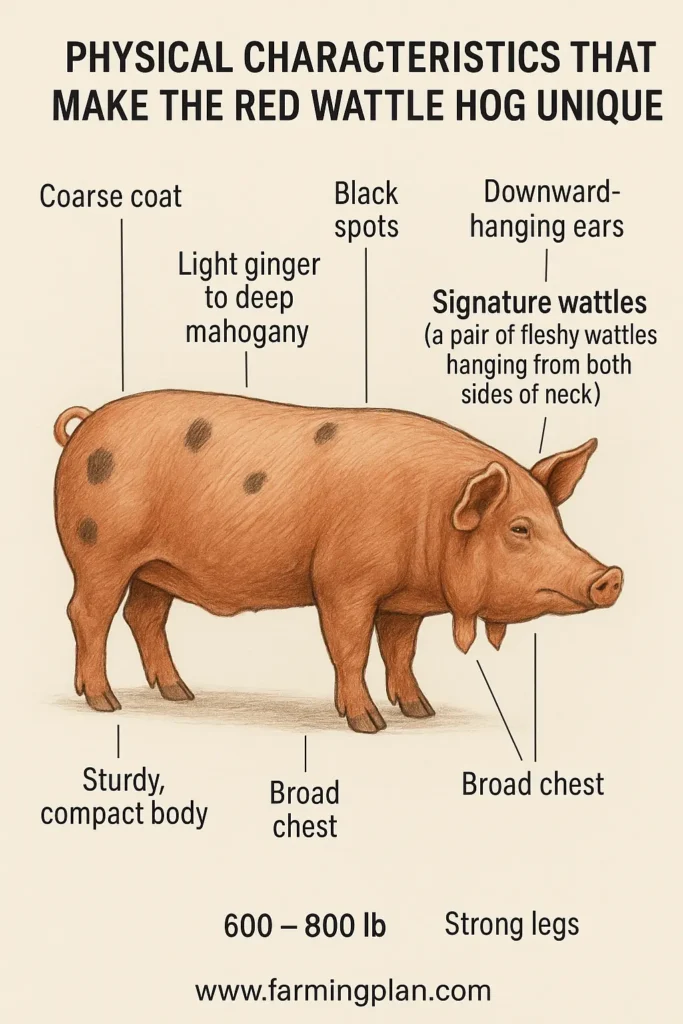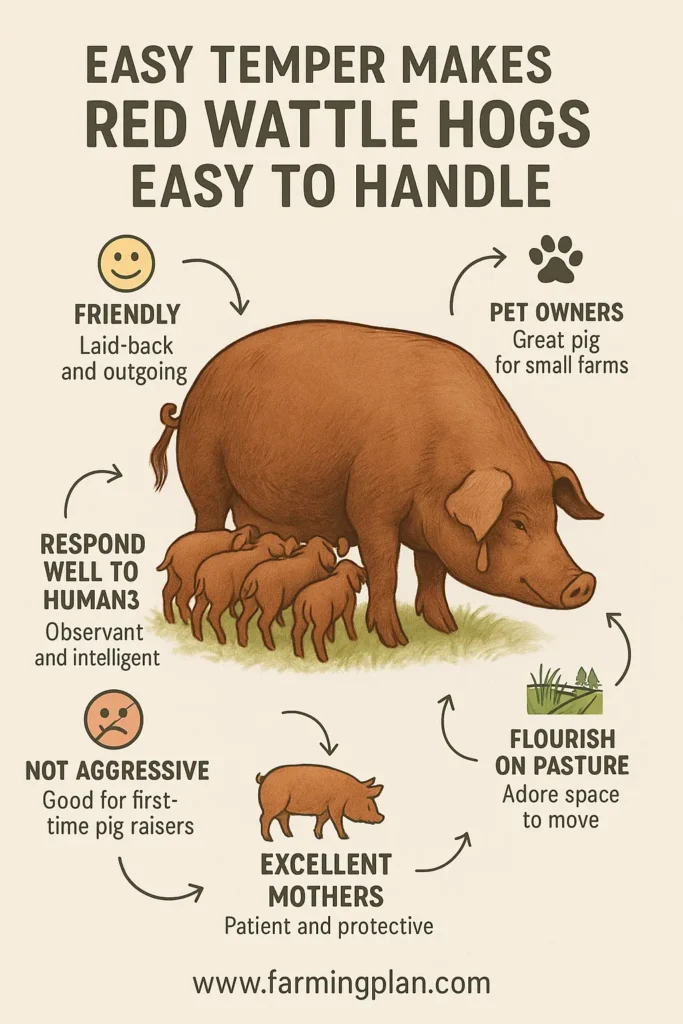The red wattle hog is a heritage pig capturing hearts in farms and homesteads. Known for its friendly temperament, distinctive wattles, and rich, flavorful meat, this unique pig is rapidly becoming the number-one choice for outdoor or pasture-raised swine production. Whether you are a homesteader, animal lover, or simply interested in wattle pigs, there’s something in this breed for everyone. Red wattle hogs are sweet with excellent maternal bearings, a tender disposition, and eye-catching facial characteristics like their fleshy set of wattles. They’re strong, reliable, and beloved to be around an excellent breed for raising on your land.

History & Origin of the Red Wattle Hog

The red wattle hog has as brash a history as its name. This heritage animal began in the woods of East Texas. A peculiar group of wild animals with typical wattles was first observed there. These hogs were in various colors, but one thing was sure—their deep red color and the typical wattles dangled from their necks. During the 1970s, Texas rancher H.C. Wengler was especially interested in these animals.
He began breeding them intentionally, noting their muscular physique, delicate meat, and friendly temperament. Another dedicated farmer, Jerry Russell, later helped to develop what is now known as the modern breed of red wattle pigs. Due to the work of these committed breeders and the work of the non-profit Livestock Conservancy, the red wattle hog is no longer vanishing into the past. It’s now a stable breed and one of the most valuable small farm livestock breeds.
Read More: Hogan Pig: Guide To Getting Started
Characteristics of the Red Wattle Hog

The red wattle hog’s appearance is recollective. It possesses a sturdy and compact body, the back having a gentle hunch and a spacious frame. Grown animals, such as pigs, are fast to reach maturity, and they weigh between 600 to 800 pounds. What really sets them apart is their signature wattles—a couple of fleshy wattles that hang off both sides of their neck. Those classic wattles are soft, skin-covered folds and one of the pig’s personal attractions. Although scientists say it’s a one-gene trait, no one knows for sure what purpose the wattles serve.
The red wattle pigs occur in light ginger to deep mahogany colors. They come with black spots or other spots of value on some, giving them that extra. Their coats are coarse, and their ears have a downward-hanging disposition. Strong legs, good muscle, and a broad chest make the Red Wattle Hog breed ideal for commercial production and pasture farming. It is not just about looks—these pigs are built to perform and deliver quality meat.
Read More: Choctaw Hog Pig: Farm Business
Easy Temper Makes Red Wattle Hogs

The red wattle hog is favored for more than just its looks. It’s also loved for its outgoing personality and gentle disposition. The pigs are laid-back, friendly, and a joy to handle—even for newbies. They’re excellent for pet owners, small farmers, or first-time pig raisers. They are not aggressive. They adore space to move and flourish on pasture systems. They’re intelligent, observant, and overall respond well to humans. Farmers say they’re among the most easy-going pigs to work with.
Red wattle pigs are also excellent mothers. They care for their piglets patiently and protect them without being too aggressive. This makes them perfect for raising a breed herd without stress or hassle. Their temperament makes them ideal for varied farms, homesteads, and even hobby breeders who want a beautiful and well-tempered heritage breed.
Read More: Guinea Hog Pig: Full life of Guinea Hog pig
What Red Wattle Hogs Eat for Better Growth and Great Pork Flavor
A proper diet is the key to keeping a red wattle hog healthy and providing delicious meat. The pigs prosper with outdoor or pasture pig production, where they can range, root, and graze freely. A proper diet includes fresh pasture, grains like barley or corn, and always clean water. Farmers provide vegetables, fruits, and food scraps—but safe food only. Never give them rotten, salty, or sugary foods.
Piglets and breeding animals need more protein and minerals. Fattening pigs should be fed a diet that helps promote healthy bones and steady weight gain. This enhances the quality of pork and maintains good health. Numerous farmers testify that red wattle’ s-wattle pork provides a sweet flavor through natural feeding and slow growth. Don’t overfeed for the best results. Well-fed pigs translate to better meat—like juicy ribs and the better pork chop everyone wants.
“Red wattle hogs aren’t just pigs—they’re a heritage breed with a rich flavor that makes every bite of pork unforgettable!”
Why Red Wattle Hogs Are a Favorite Meat Breed for Farmers
The red wattle hog is worth much, but its most significant value lies in the meat. This favorite meat breed is prized for its capability of producing luscious, tender, and savory pork of preference. From an excellent pork chop, tasty sausage, or ribs that melt within your mouth, red wattle pork is revered by chefs and small farms. Because of their rapid growth rate and strong constitution, these pigs are well-suited for commercial production and small backyard operations. Others raise them for pasture-based meat, while others raise them as breeders to develop a strong breed herd.
Aside from meat, they’re also showcased in livestock fairs or shows. Their amiable nature and distinctive wattles are a crowd favorite in the ring. Some even keep them as part of a mixed-farm homestead because they’re low-maintenance. This pig breed is best suited to old-fashioned farming and modern sustainable setups. It’s an excellent choice for those seeking high-quality meat and a reliable animal to raise.
Unique Features That Make Red Wattle Hogs One-of-a-Kind
The red wattle hog isn’t just another pig—trust me, it has some pretty cool features that set it apart. The most obvious? Its signature wattles. These two fleshy wattles hang from the neck, giving the pig its name and making it easy to identify. This feature is controlled by a single gene, so it’s a rare and special feature in pigs. Farmers also appreciate their robust mothering capacity. Red wattle sows yield generous milk supplies, causing piglets to grow big and healthy. They remain calm, too, in raising their piglets, which is ideal for anyone handling a small breed herd.
The range of colors in their coat—from light red to deep rust—adds to their beauty. Then, there is how they perform in pasture systems. They are easy to take, work well outdoors, and are hardy throughout the year. These hardy pigs have consistently good genetics and, therefore, pass along their traits reliably. This means they are the number one choice for a line of pedigree animals and anyone who desires to breed their own heritage line.
Keep Red Wattle Hogs Healthy with Intelligent Daily Care
The red wattle hog is strong and durable, yet as with any animal, it still needs proper care to be healthy. Proper living conditions, a nutritious diet, and regular checks can avoid most health problems. Some common issues are worms, skin infections, and hoof problems. Act immediately if you see symptoms like weight loss, coughing, or cuts that fail to heal. Maintain dry bedding and rotate pastures to keep diseases from spreading.
Vaccinations are also necessary. Implement a vet-recommended procedure to avoid major diseases. Keep piglets and breeding stock on shots on time and on a good feeding regimen. Daily care is essential. Clean water, summer shade, and winter shelter keep illness away. A healthy red wattle pig means improved growth, simpler breeding, and enhanced pork options.
Step-by-Step Guide to Raising Red Wattle Hogs
Whether you’re a seasoned farmer or a beginning pig owner, rearing red wattle hogs is a fulfilling adventure. Here’s a simple, step-by-step guide to raising these phenomenal creatures:
Prepare the Setup
- Space: Red wattle pigs do well in outdoor or pasture-based swine production. Ensure you provide them space to move around, forage, and root.
- Fencing: High, durable fencing is required. Red wattle hogs are intelligent and can learn to escape if the fence is insecure.
- Shelter: They need a plain, dry shelter to escape bad weather. A small barn or covered pen is best.
Choose Healthy Breeding Stock
- To raise a breeding herd, start with pedigreed animals from a proven source. Employ bright, alert eyes and clean coats to indicate health.
- Please note that their breeding lines and history maintain good qualities.
Feeding and Daily Care
- Please provide them with fresh, clean water every day. This is essential for their well-being and for the sake of high-quality pork.
- Feed them a balanced diet of pasture, grain, and rare vegetables. Adjust their diet based on whether they are growing, breeding, or maintaining.
- Check them over daily for injury or sickness. Catching a problem early will avoid more significant issues.
Keeping Healthy
- Watch for common health issues, such as skin infections, foot disease, and internal parasites. Get regular vet checks and vaccinate your pigs to keep them healthy.
- In cold months, ensure they can access dry bedding and shelter to prevent illness.
Breeding and Piglets
- Red wattle sows are good mothers, so expect an easy birthing process. After piglets are born, ensure they have access to a lot of milk and a secure growing area.
- You can start weaning piglets and slowly introduce solid foods when they are old enough.
Sustainable Practices
- Sustainable farming should involve rotating pastures to prevent disease transmission and allow the land to rest.
- Please check their weight and growth to ensure they’re healthy. Healthy pigs lead to good meat and a more enjoyable farm life.
Expert Tips and Best Practices for Raising Red Wattle Hogs
Bred red wattle hogs can be rewarding and profitable, especially after trying these expert tips. From reproduction to meat production, these are some tips that will help you make the most of your pigs’ productivity:
Use the Right Breeding Stock
- You begin by utilizing pigs with a good pedigree without genetic problems. This will ensure a healthy breed herd with the optimum traits.
- Think about cooperating with other breeders or joining breed registries so you can exchange knowledge and resources.
Provide Abundant Space
- Red wattle pigs perform best under pasture-based systems in which they can root, forage, and move about. Provide enough space For them, especially if you are breeding them for meat.
- A free-range environment improves meat quality because the pigs grow at their own rate and acquire a more enhanced flavor to their pork.
Regular Health Checks and Biosecurity
- Have a regular health check routine. Keep general diseases like parasites, skin diseases, or respiratory infections in check with regular checkups. Prevention is always better than cure.
- Implement a biosecurity program to prevent the spread of disease. Quarantine new animals for a short period before introducing them to your herd.
Monitor Their Diet
- Red wattle hogs thrive on a balanced diet. Please provide them with quality pasture supplemented with vegetables and grains. Ensure they are given the right mix of nutrients to achieve healthy growth and quality meat.
- Avoid overfeeding; letting them grow naturally on a nutritious, sustainable diet is better.
Successful Breeding Tips
- Timing is everything when breeding red wattle pigs. Breed your sows at maturity (around 1-2 years old).
- Track breeding cycles and maintain accurate records to enhance your pedigreed animal management.
Focus on Sustainability
- Rotate pastures to avoid overgrazing and allow the land to recover. This also prevents parasites from accumulating.
- Be aware of your surroundings. Red wattle hogs are tough creatures, but making them comfortable and secure living spaces is key to keeping them healthy.
FAQ
What is a red wattle hog?
Red wattle hog is a heritage breed pig with distinctive wattles—a pair of fleshy wattles hanging from each side of the neck. Red wattle hogs are hardy and kind and produce highly marbled pork with an outstanding flavor.
How big do red wattle hogs get?
Adult red wattle hogs weigh approximately 600 and 800 pounds, with others reaching 1,200. They stand approximately 4 feet tall and can reach up to 8 feet in length.
Are red wattle hogs suitable for meat production?
Yes, red wattle hogs are well-suited for meat production. Their pork is tender, marbled, and rich in flavor, which is a favorite among chefs and home cooks.
What is the temperament of red wattle hogs?
Red wattle hogs possess a mild disposition and gentle temperament. They are easy to handle, making them ideal for both new and experienced farmers.
How do I take care of red wattle hogs?
Red wattle hogs perform well under pasture systems with freedom of movement and grazing. Please provide them with clean water, a nutritious diet, and shelter during extreme weather. Frequent health inspections and vaccinations are also required.
Conclusion
Red wattle hog is a sturdy heritage type with wattles, a gentle disposition, and high-quality pork. It is excellent in pasture systems and extremely well-adapted to sustainable agriculture. Proper care, e.g., balanced ration, clear water supply, regular health checkups, and red wattle hogs, can be extremely valuable to any farm or homestead.
